As has been the case for some time now, Patek Philippe modernly offers the Aquanaut with a chronograph movement. This sporty complication fits perfectly in the company’s increasingly youthful, dynamic collection. But how does it perform in real-life conditions? We find out in this in-depth review from the WatchTime archives (original photos by Patrick Mökesch).
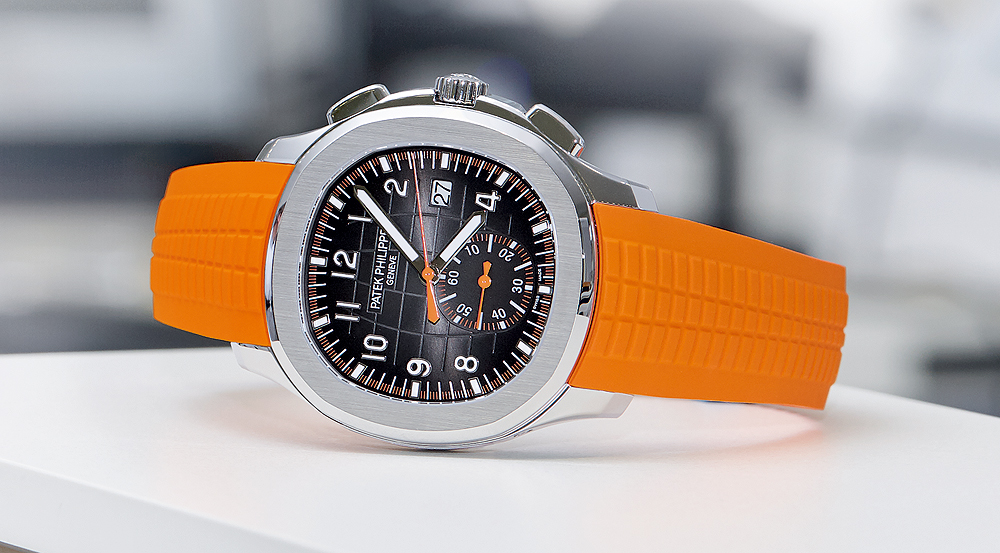
The Patek Philippe Aquanaut was first launched in 1997 and is one of the newest collections at Patek Philippe, alongside the Twenty-4 introduced in 1999. The CH 28-520 C caliber that powers the watch is almost 10 years younger still – the first chronograph movement for the Nautilus-inspired watch with its rounded octagonal bezel.
The Aquanaut Chronograph, our test watch, has a striking orange “Tropical” strap made of modern composite rubber that’s resistant to wear, saltwater and UV rays, and is combined with a new double folding clasp. With four independent catches and two side buttons, its patented design offers extreme reliability and ease of operation. It is attached with two spring bars at the strap ends so the strap must be trimmed to the wearer’s individual wrist size – a powerful move that doesn’t allow for mistakes. And in the event of a different occasion, Patek Philippe also delivers the Aquanaut Chronograph with an additional black strap.
For added stability on the wrist, the strap ends on the case are secured not only by conventional spring bars but also by two pins that lead from the strap ends into the body of the case. Therefore, Patek Philippe recommends having the strap changed by an authorized service person, which limits its ease of use.
But why change the strap at all? We found that the orange strap highlights the colorful accents that mark the chronograph functions on the dial; the long, slender chronograph hand that extends from the center of the dial; the minutes hand over the subdial at 6 o’clock; the markings of the 4-Hz chronograph track around the dial as well as the elapsed-minutes track around the subdial. This adopts the same shape as the rounded octagon of the bezel. On the other hand, the design on the surface of the strap blends nicely with the relief embossing on the Aquanaut’s main dial, which references the Earth’s coordinate system. Light plays on the dial’s sunburst finish so it sometimes appears deep black and sometimes light gray. Applied Arabic numerals, 12 markers, and the two bold baton-shaped hands for the hours and minutes are all made of white gold and have luminescent coating so the time is easy to read, day or night, thanks to the strong black-and-white contrast and the glowing green luminescence at night. The orange brass hands of the chronograph function are painted, and have no luminescent accents, but they point precisely to the chronograph scales on the dial.
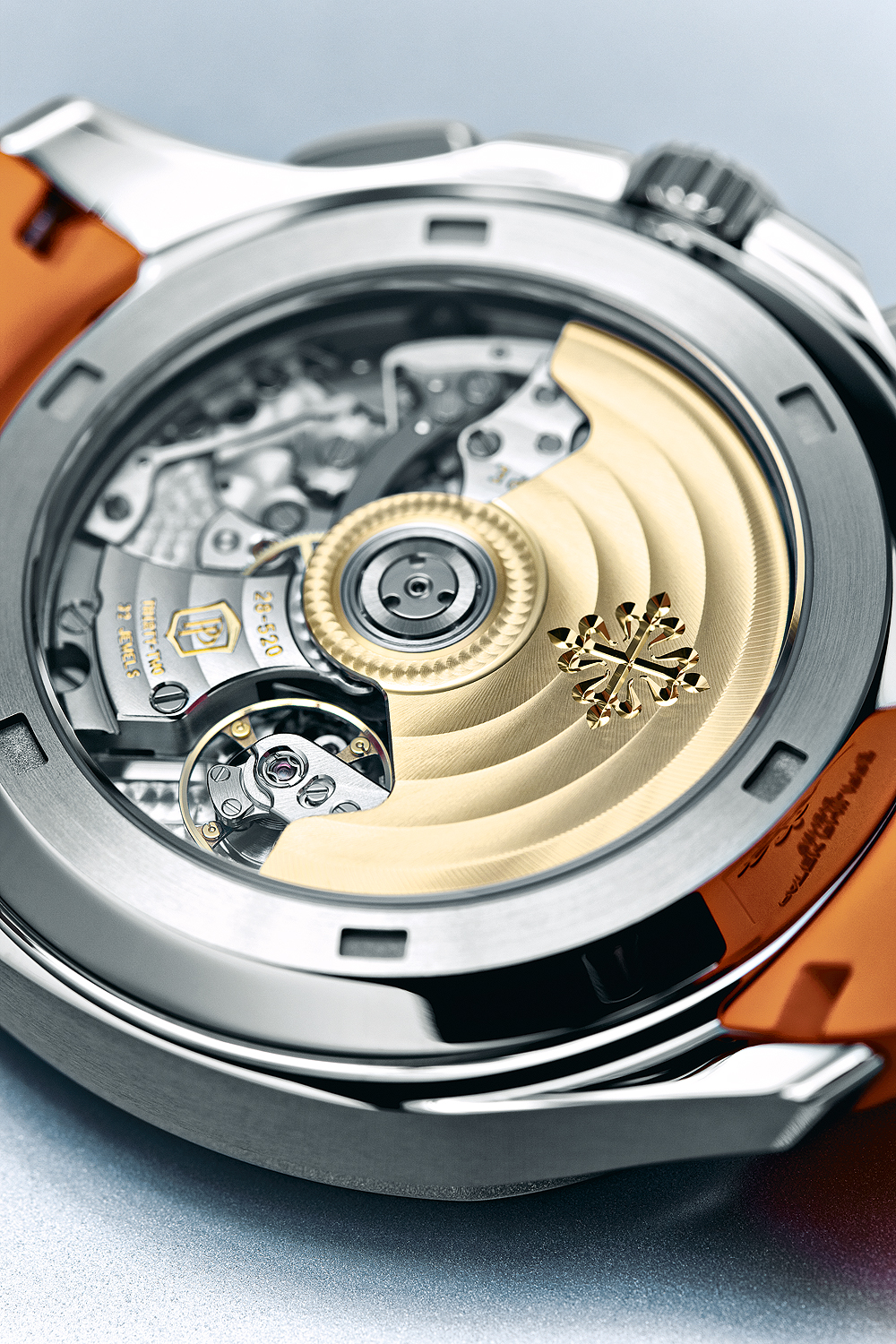
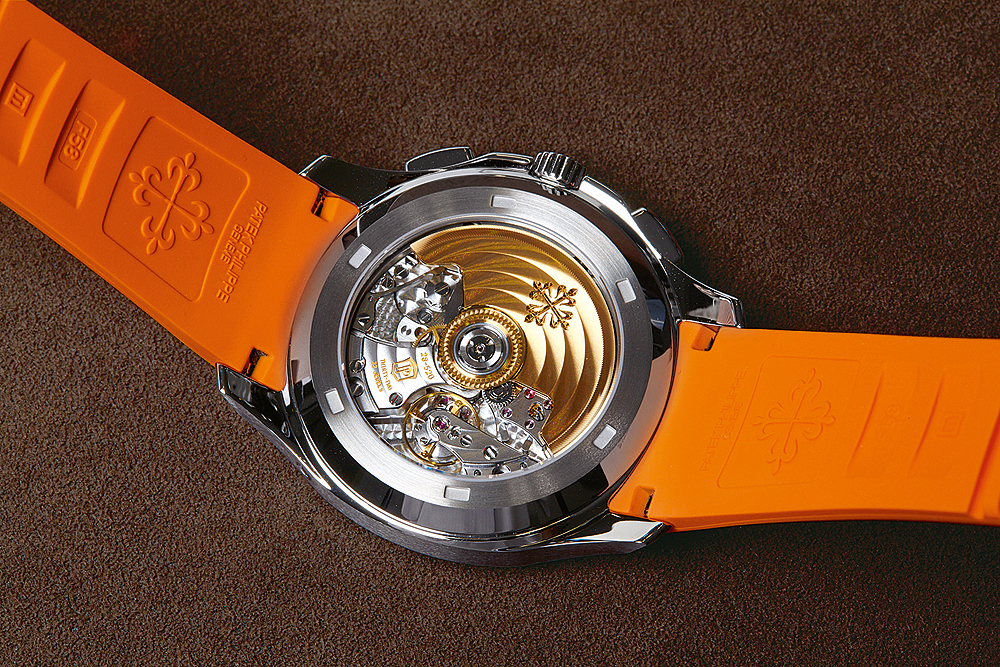
Self-winding Caliber CH 28-520 C ensures a high level of accuracy, combining a classic column wheel with a modern vertical-disk clutch control. It is the only chronograph movement at Patek Philippe with this type of clutch. Its design prevents any forward or backward jumping of the stopwatch hand when the chronograph is engaged and it runs so smoothly that the centrally mounted chronograph hand can also be used as a permanent sweep seconds hand, which is why the Aquanaut Chronograph does not have a separate seconds hand. The flyback function makes it possible to set the watch precisely, to the second. The stopwatch hand can be set to zero from an ongoing measurement without a reset and restarted immediately. Of course, this also works by starting the chronograph precisely at a time signal. The only drawback: the movement has no hack mechanism so it may be necessary to reset the minutes hand.
Caliber CG 28-520 C has undergone some design changes for use in the Aquanaut. The hour counter has been omitted completely. But what young, dynamic person today needs such a thing? Elapsed minutes are easy to read on the large subdial counter, since it extends almost to the center of the dial and is intuitive – the 60-minute counter mirrors the standard minutes display on a watch dial (instead of a more commonly used 30-minute counter). A minute counter wheel rotating below operates with a direct transmission ratio to the chronograph runner, which allows the elapsed minutes display to run continuously and does not jump when the second hand passes “zero.” This mechanism is placed on the dial side of the chronograph.


The date is also noteworthy. It advances at midnight within a fraction of a second – so fast that the human eye cannot register it. It can be adjusted (with some effort) via an integrated pusher at 8 o’clock. Patek Philippe supplies a correction stylus made of ebony and white gold, but a crown-based function would be more convenient.
The self-winding movement has a 21k gold rotor and can build up a power reserve of up to 55 hours. Verifying the power reserve was part of our testing program, which was analogous to Patek Philippe’s quality control in its Munich workshop. When fully wound, the movement is specified to run 56 hours. Our test recorded 57 hours and 48 minutes. A second test simulating actual wear examined the efficiency of the winding mechanism. After winding for one hour and 34 minutes the watch should run for 18 hours. Our Aquanaut Chronograph clocked in at 24 hours.
In the simulated wearing test – while the chronograph is engaged – the watch ran with virtually no deviations at all. When fully wound and with the chronograph running, the timing machine recorded an average daily rate of -0.4 seconds per day, and after 24 hours of running time, without additional winding, the rate was -0.7 seconds. The values were similar when the chronograph function was not engaged. Amplitudes differed by about 10 degrees.
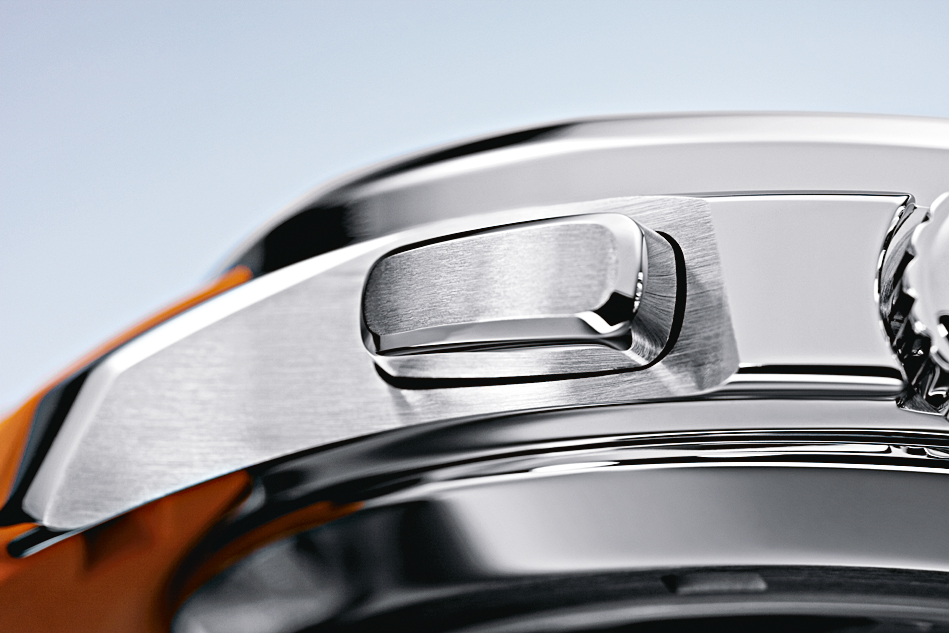
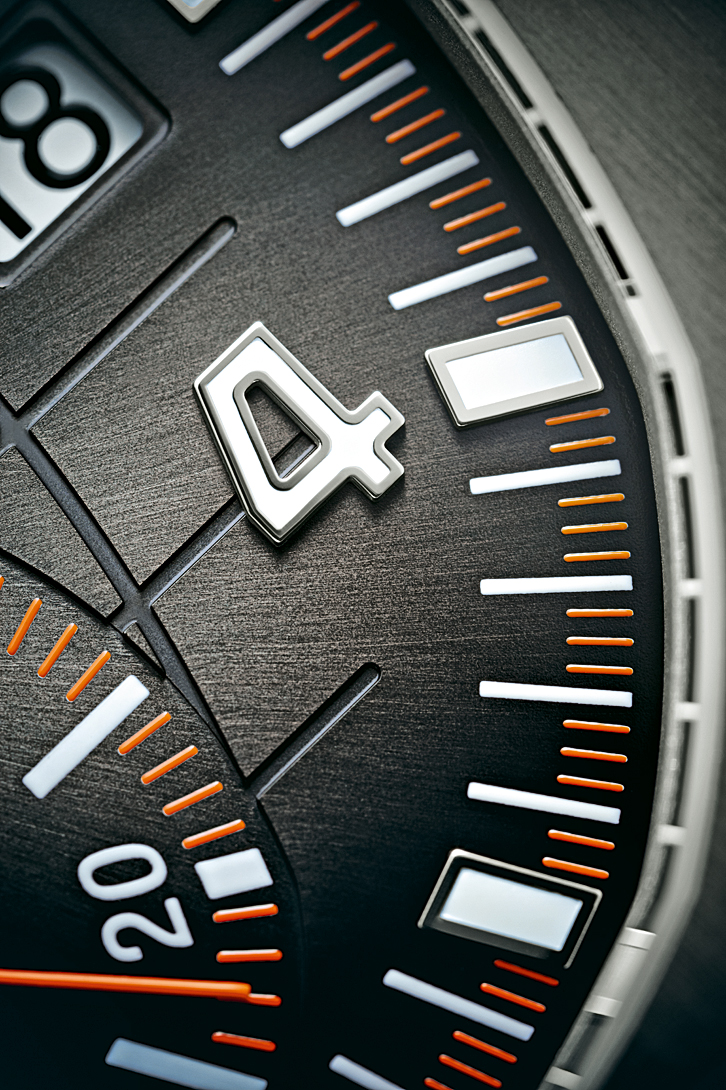
Specifications from Patek Philippe – within the framework outlined by its own quality seal – lie between -3 and +2 seconds per day. Our test watch remained reliably in this tolerance range. Caliber CH 28-520 C easily achieved these rate results with a system consisting of the long-standing Gyromax balance wheel (patented in 1949 and 1951) and the Spiromax hairspring made of Silinvar (introduced in 2006).
This new, patented material is based on a monocrystalline form of silicon, which is temperature-compensating, lightweight, hard, wear-resistant, anti-magnetic, elastic and resistant to corrosion and impacts. It is produced using the DRIE (Deep Reaction Ion Etching) process with a precision of 1/1,000th of a millimeter. When combined with the fine regulation using the asymmetrical regulating weights on the balance wheel, rate accuracy is optimized and isochronism is improved, as our tests showed.
The watch mechanism is housed in a stainless-steel case that sports both polished and brushed finishes and is water resistant to a depth of 120 meters. The crown guard gives it a slightly asymmetrical look. All screw-down operating elements functioned perfectly. Manual winding and setting operations are both extremely smooth. The wide, faceted chronograph pushers require firm pressure due to the jaws that hold and release the vertical clutch. Start and stop functions using the pusher at 2 o’clock work a little bit easier than the flyback and reset pusher at 4 o’clock. All these actions work reliably and consistently, aided in no small part by the brushed finish on the top of both chrono pushers.
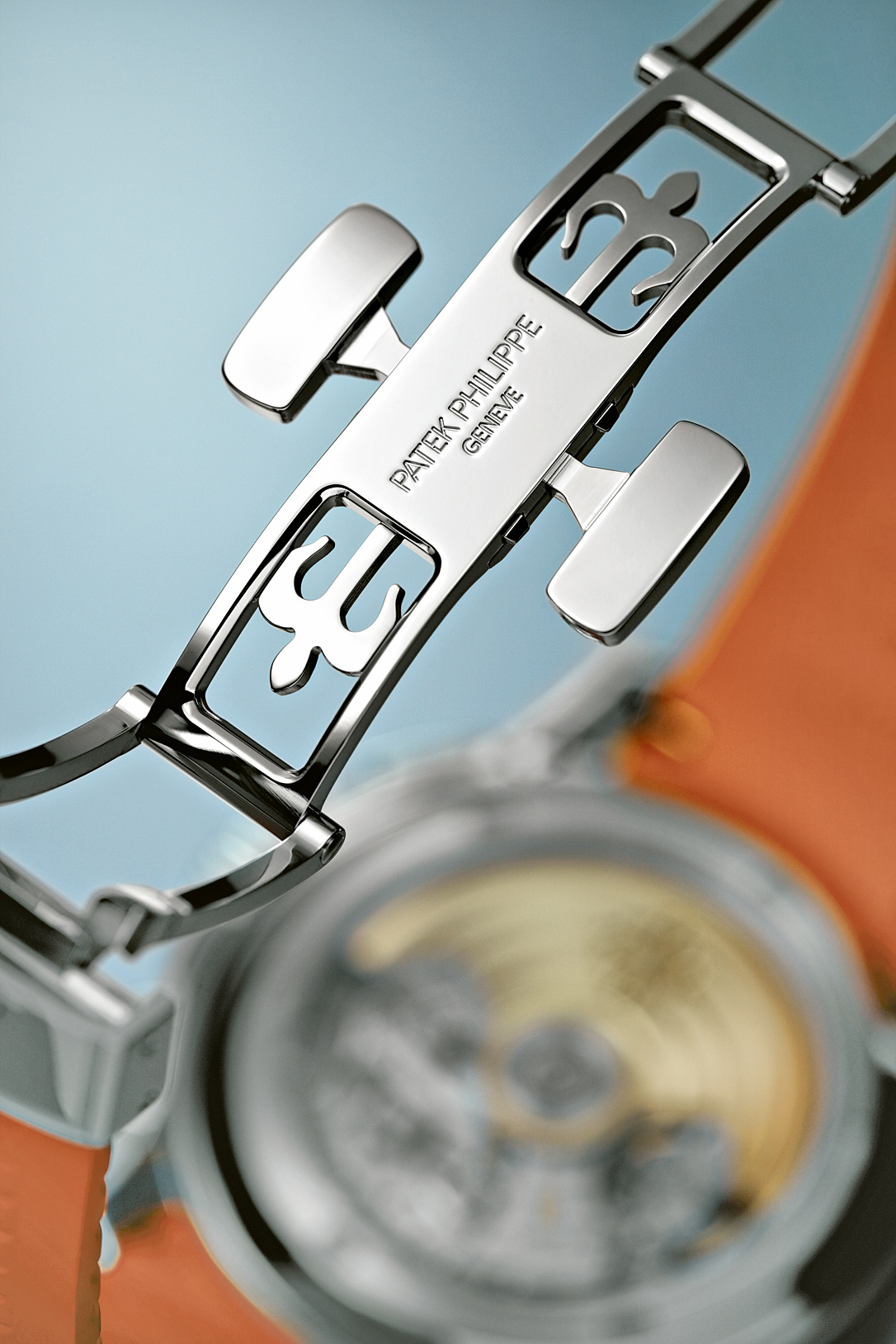
The Aquanaut Chronograph lies snugly against the wrist thanks to downward sloping lugs and the attachment of the rubber strap. The clasp closes softly and securely and the crown has a solid and sumptuous feel. Both are exceptional in their operation. The youthful, dynamic spirit of this sporty timepiece extends to every last detail.
SPECS:
Manufacturer: Patek Philippe SA, Chemin du Pont-du-Centenaire 141, 1228 Plan-les-Ouates, P.O. Box 2654, 1211 Geneva 2, Switzerland
Reference number: 5968A-001
Functions: Hours, minutes, chronograph, central elapsed seconds (can also be used as a running seconds hand), 60-minute counter at 6 o’clock, flyback, date
Movement: Caliber CH 28-520 C, automatic, 28,800 vph, 32 jewels, Gyromax balance, Spiromax (Silinvar) hairspring, regulating weights on balance wheel, Incabloc shock absorber, 55-hour power reserve, diameter = 30.0 mm, height = 6.63 mm
Case: Stainless steel, sapphire crystal above the dial, sapphire caseback, water resistant to 120 meters
Strap and clasp: Composite material strap, one in black and one in orange, double stainless-steel folding clasp with push-buttons
Rate results (deviation in seconds per 24 hours, fully wound/after 24 hours):
Simulated wear test +/- 0.0
Dial up +2.0 / +2.2
Dial down +4.7 / +4.5
Crown up -3.2 / -3.6
Crown down +1.4 / +1.2
Crown left -2.3 / -1.4
Crown right -1.2 / -4.4
Greatest deviation 7.9 / 8.1
Average deviation +0.2 / -0.3
Average amplitude:
Flat positions 300° / 279°
Hanging positions 261° / 242°
Dimensions: Diameter = 42.2 mm (measured 10 to 4 o’clock), 40.1 mm (measured 12 to 6 o’clock), height = 11.9 mm, weight = 117.5 g
Price: $43,770


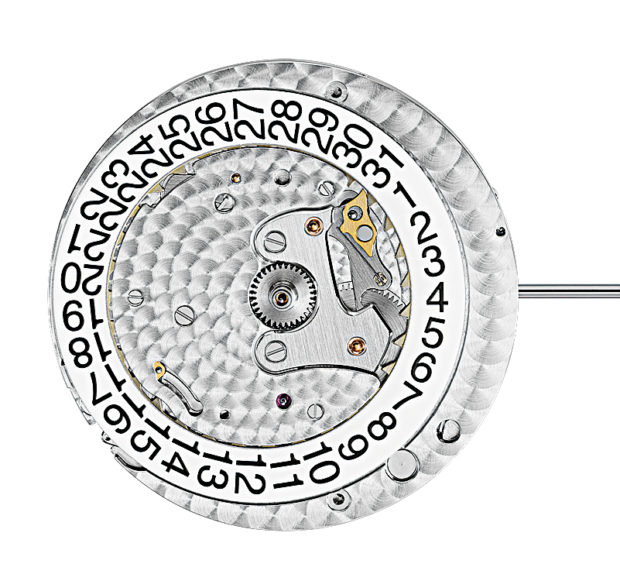

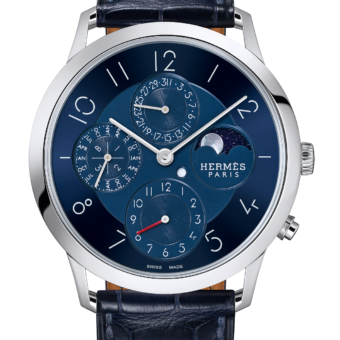
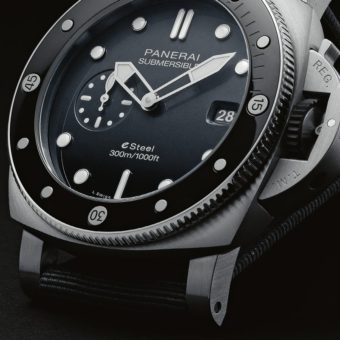

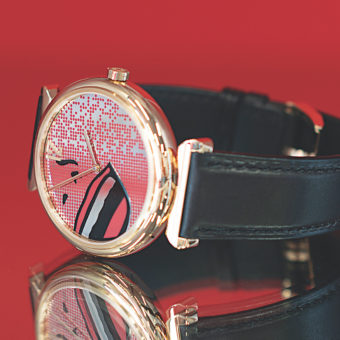
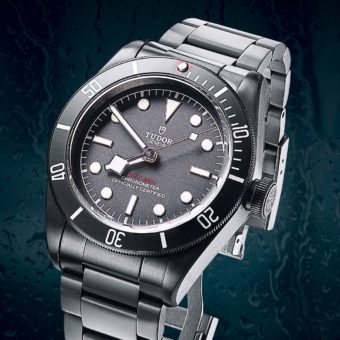
Save the cost and by a by a Timex. They’re looking very good now.
Better to take the cost and distribute it to the poor.Then go out and by a Timex.
This would make a nice beater
This should be made at a price non-oligarchs can afford. It is a SS watch ! Likely sells for double the $43 K price due to artificial scarcity. Yep
nothing dramatic, regular chrono watch
When will this model be available to purchase no reply from you
Please note: We do not sell watches. Availability has to be checked with your AD.
Reading through the review is quite itimidating to me as I am not familiar with technical details of this magnificient time-piece. I probably need help from an expert but I like this machine. What is the waiting time to purchase the Aquanaut Chronograph currently?
It can be very long on the Aquanaut line; by long, I mean well known billionaire Kevin O’Leary waited 8 years for his. Granted it was not the chronograph but the much sought after time-only steel version, but still. Expect a few years I would say, unless you want to go get it from a non-authorized reseller in which case availability can be immediate but prices can be two, three, four, five times the retail price (I am not kidding).
Kevin O’Leary was waiting and ultimately purchased a Nautilus, not Aquanaut… though, I’ve seen a red strapped Patek Aquanaut on him in a fintech video; the red Aq is from Asia/Singapore…
Reading through the review is quite itimidating to me as I am not familiar with technical details of this magnificient time-piece. I probably need help from an expert but I like this machine.
Numerals “do not glow at night” ??????
The hour counter has been omitted but who needs it?
Me! I need it to time my bike rides and it’s the only reason I would buy a chronograph so it’s the first thing I look for.
Hi Stevie,
A word of advice: you don’t wear your PP for your bike rides. You wear your Garmin Fenix 5. Therefore if you fall at 25 mph, as it happened to me, aside from your bones and skin, you only ruin a $500 timepiece, easily replaceable…
Would like to buy a 5160 for a please let me know if you have any